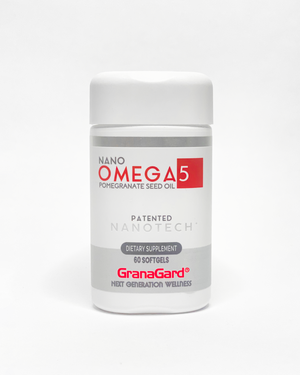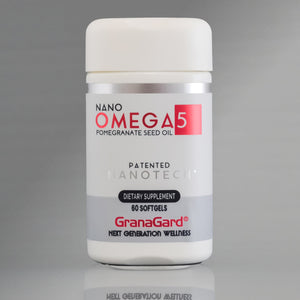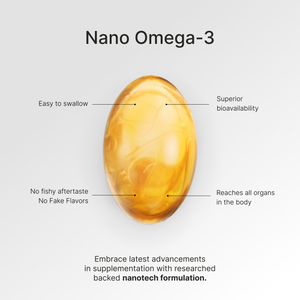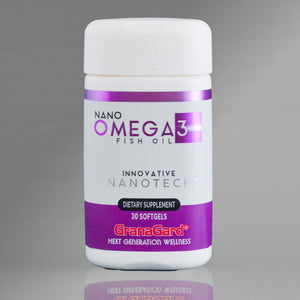Common liver disease, with a prevalence of 25% worldwide. If the factors that cause it are not corrected, it can progress to cirrhosis or hepatocellular carcinoma. Omega 3 helps control many of the factors that cause it.
What is Fatty Liver

What most people know as fatty liver disease, medically defined as non-alcoholic fatty liver disease (NAFLD), is a spectrum of liver diseases ranging from hepatic macrosteatosis, defined as the accumulation of lipids (fatty acids, triglycerides, cholesterol...) in the liver, appearing as small fat droplets, to non-alcoholic steatohepatitis (NASH) where there is inflammation and liver injury; which in turn, can progress to cirrhosis or hepatocellular carcinoma.
Between 7% and 30% of patients with non-alcoholic fatty liver disease progress to non-alcoholic steatohepatitis; and between 20% and 30% of patients with non-alcoholic steatohepatitis develop cirrhosis, which can progress to hepatocellular carcinoma and liver failure. Non-alcoholic steatohepatitis (loss of liver function), cirrhosis, and hepatocellular carcinoma are expected to increase by 168%, 137%, and 178%, respectively, by 2030.
Non-alcoholic fatty liver disease is associated with Metabolic Syndrome, which is a group of conditions that include hyperglycemia, excess body fat, dyslipidemia (elevated cholesterol and/or triglyceride levels in the blood), and hypertension.
Obesity, (Oxidative stress and obesity) type 2 diabetes, (Oxidative stress can cause Type 2 diabetes), metabolic syndrome, and dyslipidemia are the four main risk factors. The severity of obesity increases the incidence of non-alcoholic fatty liver disease, ranging from 75% in overweight people to 90-95% in morbidly obese individuals.
Multiple factors contribute to the onset of non-alcoholic fatty liver disease, including gender, diet, (What are the best antioxidant foods) lifestyle, and genetics. Both children and adults can develop it.
Events and Factors That Trigger Fatty Liver
Fatty liver does not develop overnight; it is the result of a series of factors that contribute, in sequence or in parallel, to the onset of the condition. We will schematically describe these factors below.
Lipid Overload
The accumulation of lipids in the liver is considered the first factor in a multi-hit process that leads to fatty liver. Various pathways contribute to elevated hepatic lipid levels. The first is the absorption of non-esterified fatty acids from the circulation, originating from adipose tissue. This pathway accounts for 59% of lipid overload and would justify the high association between fatty liver, overweight, and obesity.
The second pathway is the synthesis of new lipids by the liver, a process known as de novo lipogenesis, where the raw material comes from the high carbohydrate content of the diet, together with high insulin levels. This pathway contributes 26% of the lipid overload. There are other pathways that supply lipids, but in lesser amounts.
Oxidation
Excess lipids entering hepatocytes (liver cells) overload the mitochondrial oxidation process. Mitochondria are the organelles within cells responsible for energy production; they do this through their metabolism, and oxidation is part of this process. The accumulation of lipids disrupts the metabolic process and generates reactive oxygen species within the mitochondria, substances that are highly oxidative and can alter the structure of lipids, proteins, and nucleic acids (DNA), leading to mitochondrial damage, mitochondrial dysfunction, and ultimately, cell (hepatocyte) damage and death.
Inflammation
Increased oxidative stress promotes the production of inflammatory substances, which increases mitochondrial stress, liver injury, and cell damage. This leads to the activation of hepatic stellate cells, a group of cells involved in the structure of the organ but not its function. They will become part of the remodeling process, which, if not stopped, results in liver fibrosis.
Gut Microbiota
A relatively recent topic that would explain some of the factors necessary to understand the evolution of the fatty liver condition is the gut microbiota. (Omega 3 to improve your gut microbiota health) We must remember that the liver is the first organ to encounter the products absorbed by the intestine.
In addition to the absorption of micro and macronutrients, the products derived from the intestine also include bacterial components. Liver cells use some substances from the bacterial metabolism of the gut microbiota (Omega 3 to improve your gut microbiota health) to synthesize other useful compounds. Such is the case of butyrate derived from the metabolism of colon microbiota.
However, other microbial products have adverse effects on liver cells, as well as systemically. Endotoxins are toxic substances produced by another group of bacteria in the altered gut microbiota. Endotoxemia (presence of endotoxins in the blood), for example, is commonly associated with fatty liver.
The appearance of microbial products derived from the intestine in the circulation may be due to a failure in the integrity of the intestinal barrier where tight junctions between enterocytes (intestinal cells) are damaged (leaky), leading to increased permeability and the presence of toxic intestinal products in the circulation.
Endotoxins are a second source for the production of inflammation; they also activate the immune response, generating factors that promote hepatic infiltration, remodeling processes, and ultimately, fibrosis.
Why Omega 3 Works Against Fatty Liver
Omega 3 are polyunsaturated fatty acids that, due to their properties, provide extraordinary health benefits. In the case of fatty liver, Omega 3 (10 Omega 3 body systems organs benefits) act on virtually all factors that cause the onset and progression of fatty liver.
Omega 3 reduces triglyceride levels and has a suppressive effect on certain enzymes responsible for their synthesis. In fact, Omega 3 is widely used to reduce triglyceride and cholesterol levels as risk factors for cardiovascular diseases. (Benefits of Omega 3 for cardiovascular health) Knowing that liver lipid overload is a factor in the onset of fatty liver, reducing this load will help.
Omega 3 has proven antioxidant and anti-inflammatory properties. As an antioxidant, it will help restore oxidative balance within the hepatocyte and control mitochondrial dysfunction; as an anti-inflammatory, it will reduce the appearance of inflammatory mediators, preventing the emergence of an immune response that leads to further inflammation and remodeling and fibrosis processes.
Omega 3 has been shown to modulate the gut microbiota, restoring balance, favoring beneficial bacterial strains for our health, such as butyrate producers; controlling endotoxin-producing strains, or those responsible for damage to the intestinal barrier, which would prevent toxins from entering the liver and generating new inflammatory factors. Definitely, Omega 3 (10 Omega 3 body systems organs benefits) have the resources to help control fatty liver.
Next Generation Omega 3
Conventional Omega 3 has physicochemical characteristics that make them liposoluble, meaning they dissolve well in fatty tissues but not in those with hydrophilic conditions, with a greater affinity for water.
Nanotechnology (What is Nanotechnology in simple words) has managed to turn Omega 3 into a Nanoemulsion, allowing it to dissolve in water and oil. This has given it 4 times more potency in terms of absorption and bioavailability compared to conventional Omega 3.
To prevent or control fatty liver, we must adopt good habits that include diet and physical activity; keep predisposing diseases (if present) well-controlled; and protect ourselves daily with Nano Omega 3 from GranaGard®





